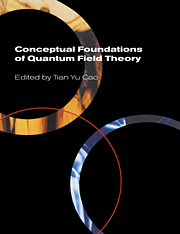Book contents
- Frontmatter
- Contents
- List of contributors
- Preface
- Photographs of the conference
- Introduction: Conceptual issues in quantum field theory
- Part One Philosophers' interest in quantum field theory
- Part Two Three approaches to the foundations of quantum field theory
- Part Three
- Part Four Mathematics, statistics and quantum field theory
- Part Five Quantum field theory and space-time
- Part Six
- Part Seven Renormalization group
- Part Eight Non-Abelian gauge theory
- Part Nine The ontology of particles or fields
- 22 The ineliminable classical face of quantum field theory
- 23 The logic of quanta
- 24 Do Feynman diagrams endorse a particle ontology? The roles of Feynman diagrams in S-matrix theory
- 25 On the ontology of QFT
- Part Ten
- Name index
- Subject index
22 - The ineliminable classical face of quantum field theory
Published online by Cambridge University Press: 22 September 2009
- Frontmatter
- Contents
- List of contributors
- Preface
- Photographs of the conference
- Introduction: Conceptual issues in quantum field theory
- Part One Philosophers' interest in quantum field theory
- Part Two Three approaches to the foundations of quantum field theory
- Part Three
- Part Four Mathematics, statistics and quantum field theory
- Part Five Quantum field theory and space-time
- Part Six
- Part Seven Renormalization group
- Part Eight Non-Abelian gauge theory
- Part Nine The ontology of particles or fields
- 22 The ineliminable classical face of quantum field theory
- 23 The logic of quanta
- 24 Do Feynman diagrams endorse a particle ontology? The roles of Feynman diagrams in S-matrix theory
- 25 On the ontology of QFT
- Part Ten
- Name index
- Subject index
Summary
An Interpretive Introduction to Quantum Field Theory (Teller 1995; hereafter IIQFT) supersedes most of my prior work on quantum field theory. The gossip mill has described this book as a popularization of the most elementary parts of Bjorken and Drell (1965), which into the 1980s was the most widely used quantum field theory text. As with any good caricature, there is a great deal of truth in this comparison. Like Bjorken and Drell, who published in 1965, IIQFT presents the theory largely as it existed in the 1950s. But in order to see aspects of structure and interpretation more clearly, IIQFT presents the theory stripped of all the details needed for application. IIQFT also does not treat contemporary methods, such as the functional approach, and important recent developments, especially gauge theories and the renormalization group. Nonetheless it is hoped that by laying out the structure of the theory's original form in the 1950s, much of which survives in contemporary versions, and by developing a range of ways of thinking about that theory physically, one does essential ground work for a thorough understanding of what we have today.
Why do we use the term ‘quantum field theory’? A good fraction of the work done in IIQFT aims to clarify the appropriateness, accurate development, and limitations of the application of the epithet ‘field’, as well as examination of alternatives. While called a ‘field theory’, quantum field theory (QFT) is also taken to be our most basic theory of ‘elementary particles’.
- Type
- Chapter
- Information
- Conceptual Foundations of Quantum Field Theory , pp. 314 - 323Publisher: Cambridge University PressPrint publication year: 1999
- 1
- Cited by



